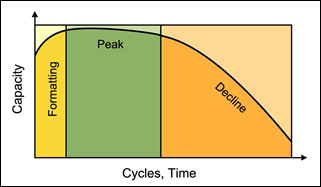How to Prime Battery
How to Prime Batteries
Discover what a battery needs to get going and maintain a long life.
In many ways, a battery behaves like a human being. It senses the kindness given and delivers on the care given. It is as if the battery has feelings and returns on the benevolence bestowed. But there are exceptions, as any parent raising a family will know; and the generosity conferred may not always deliver the anticipated returns.
To become a good custodian, you must understand the basic needs of a battery, a subject that is not taught in school. This section teaches what to do when the battery is new, how to feed it the right “food” and what to do when putting the pack aside for a while. Chapter 7 also looks into restrictions when traveling with batteries by air and how to dispose of them when their useful life has passed.
Just as a person’s life expectancy cannot be predicted at birth, neither can we date stamp a battery. Some packs live to a great old age while others die young. Incorrect charging, harsh discharge loads and exposure to heat are the battery’s worst enemies. Although there are ways to protect a battery, the ideal situation is not always attainable. This chapter discusses how to get the most from our batteries.
Priming a New Battery
Not all rechargeable batteries deliver the rated capacity when new, and they require formatting. While this applies to most battery systems, manufacturers of lithium-ion batteries disagree. They say that Li-ion is ready at birth and does not need priming. Although this may be true, users have reported some capacity gains by cycling after a long storage.
“What’s the difference between formatting and priming?” people ask. Both address capacities that are not optimized and can be improved with cycling. Formatting completes the fabrication process that occurs naturally during use when the battery is being cycled. A typical example is lead- and nickel-based batteries that improve with usage until fully formatted. Priming, on the other hand, is a conditioning cycle that is applied as a service to improve battery performance during usage or after prolonged storage. Priming relates mainly to nickel-based batteries.
Lead Acid
Formatting a lead acid battery occurs by applying a charge, followed by a discharge and recharge. This is done at the factory and is completed in the field as part of regular use. Experts advise not to strain a new battery by giving it heavy duty discharges at first but gradually working it in with moderate discharges, like an athlete trains for weight lifting or long-distance running. This, however, may not be possible with a starter battery in a vehicle and other uses. Lead acid typically reaches the full capacity potential after 50 to 100 cycles. Figure 1 illustrates the lifespan of lead acid.
|
| Figure 1: Lifespan of Lead Acid A new lead acid battery may not by fully formatted and only attains full performance after 50 or more cycles. Formatting occurs during use; deliberate cycling is not recommended as this would wear down the battery unnecessarily. |
Deep-cycle batteries are at about 85 percent when new and will increase to 100 percent, or close to full capacity, when fully formatted. There are some outliers that are as low as 65 percent when tested with a battery analyzer. The question is asked, “Will these low-performers recover and stand up to their stronger brothers when formatted?” A seasoned battery expert said that “these batteries will improve somewhat but they are the first to fail.”
The function of a starter battery lies in delivering high load currents to crank the engine, and this attribute is present from the beginning without the need to format and prime. To the surprise of many motorists, the capacity of a starter battery can fade to 30 percent and still crank the engine; however, a further drop may get the driver stranded one morning.
If you have a suggestion or would like to report an error, please use the "contact us" or email us at: jwt_gz@jinweite.net .We would like to hear from you, or we recommend posting your questions in the comments sections to share. Thank you !



